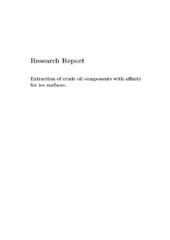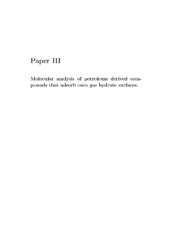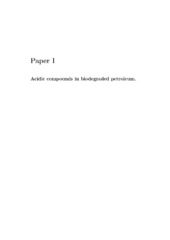| dc.contributor.author | Borgund, Anna Elisabet | eng |
| dc.date.accessioned | 2007-09-04T12:37:28Z | |
| dc.date.available | 2007-09-04T12:37:28Z | |
| dc.date.issued | 2007-06-28 | eng |
| dc.identifier.isbn | 978-82-308-0406-3 (print version) | en_US |
| dc.identifier.uri | https://hdl.handle.net/1956/2357 | |
| dc.description.abstract | Some crude oils are believed to contain natural inhibiting components that can prevent hydrate plugging of oil pipelines in petroleum production. A method for classification of the oils that form hydrate plugs, as opposed to those that are not problematical, can change the hydrate inhibiting strategies for oil companies, and result in both economical savings and environmental improvements. Furthermore, an identification of natural hydrate plug inhibiting components can eventually give rise to development of more economical and environmentally friendly inhibitors that can be added to crude oil in pipelines. This thesis addresses the issues of chemical characterisation of crude oil with respect to identification of natural plug inhibiting components. Natural plug inhibiting components are probably hydrate surface active, e.g. an acid fraction has previously been shown to be able to convert a plugging oil into a non-plugging oil when added in a low concentration. In this work, methods for extraction of surface active compounds in crude oil have been established; two methods for acid extraction have been tested (liquid-liquid and ion exchange), and in addition components with affinity for freon hydrate and ice surfaces have been extracted. The extracts have been characterised with chromatographic and spectroscopic methods, e.g. an HPLC method for separation of extracts into four groups have been developed; non-polar compounds, saturated carboxylic acids, phenolic compounds and polyfunctional compounds. The results show that the ion exchange is more effective than the liquidliquid method for extraction of acids from crude oil. Freon hydrates are found to extract a specific fraction with polar compounds from crude oil, while ice does not seem to be a good surface for extraction of components. Compounds which absorb to hydrate surfaces are found to be dominated by saturated carboxylic acids, and to contain lower amounts of phenols and polyfunctional compounds. In general, crude oil extracts primarily contain components of intermediate molecular weights. This means that neither high-molecular compounds such as asphaltenes, nor simple low-molecular petroleum acids and bases are present to a large extent in these extracts. FTIR analysis can to some degree differentiate between freon hydrate extracts from plugging and non-plugging crude oils. GC-MS is not suited for the extracts used in this thesis due to limitations regarding molecular weights and low volatility. LC-MS analysis with Ion Trap MS has been tested at the University of Newcastle, but was not optimal for our samples. The freon hydrate extracts have been analysed for compounds similar to a biosurfactant structure, but no such compounds could be found. No structural identification of the natural inhibiting components have been obtained. However, new methods for extraction of components with affinity for freon hydrate and ice surfaces have been developed and acid extraction methods from the literature have been tested. In addition, a set of analytical methods that can characterise the fractions have been established. One reason for the difficulty of identifying the natural inhibiting components can be that they are present in very low amounts, but it may also be that the distribution of compounds in the fractions is as important as the presence of specific molecules. | en_US |
| dc.language.iso | eng | eng |
| dc.publisher | The University of Bergen | en_US |
| dc.relation.haspart | Paper I: Organic Geochemistry 35, Barth, T.; Høiland, S.; Fotland, P.; Askvik, K. M.; Pedersen, B. S.; Borgund, A. E., Acidic compounds in biodegraded petroleum, pp. 1513-1525. Copyright 2004 Elsevier. | en_US |
| dc.relation.haspart | Paper II: Høiland, S.; Borgund, A. E.; Barth, T.; Fotland, P.; Askvik, K. M., Wettability of freon hydrates in crude oil/brine emulsions: the effect of chemical additives, Proceedings, Volume 4, 1151-1161, 5th International Conference on Gas Hydrates, 13.-16. June 2005. Copyright 2005 Tapir Academic Press. | en_US |
| dc.relation.haspart | Paper III: Borgund, A. E.; Høiland, S.; Barth, T.; Fotland, P.; Askvik, (2006), K. M., Molecular analysis of petroleum derived compounds that adsorb onto gas hydrate surfaces. Preprint. Submitted to Applied Geochemistry. Published by Elsevier. | en_US |
| dc.relation.haspart | Paper IV: Journal of Chromatography A 1149, Borgund, A. E.; Erstad, K.; Barth, T., Normal phase High Performance Liquid Chromatography for fractionation of organic acid mixtures extracted from crude oils, pp. 189-196. Copyright 2007 Elsevier. Published version available at: <a href="http://dx.doi.org/10.1016/j.chroma.2007.03.046"target=blank=_>http://dx.doi.org/10.1016/j.chroma.2007.03.046</a> | en_US |
| dc.relation.haspart | Paper V: Borgund, A. E.; Erstad, K.; Barth, T., (2007), Fractionation of crude oil acids by HPLC and characterisation of their properties and effects on gas hydrate surfaces. Preprint. Submitted to Energy and Fuels. Published by American Chemical Society. Full-text not available due to publisher restrictions | en_US |
| dc.relation.haspart | Research Report: Borgund, A. E., (2006), Extraction of crude oil components with affinity for ice surfaces. Report to Norsk Hydro Research Centre 2006. | en_US |
| dc.title | Crude oil components with affinity for gas hydrates in petroleum production | en_US |
| dc.type | Doctoral thesis | |
| dc.subject.nsi | VDP::Matematikk og Naturvitenskap: 400::Kjemi: 440 | nob |





